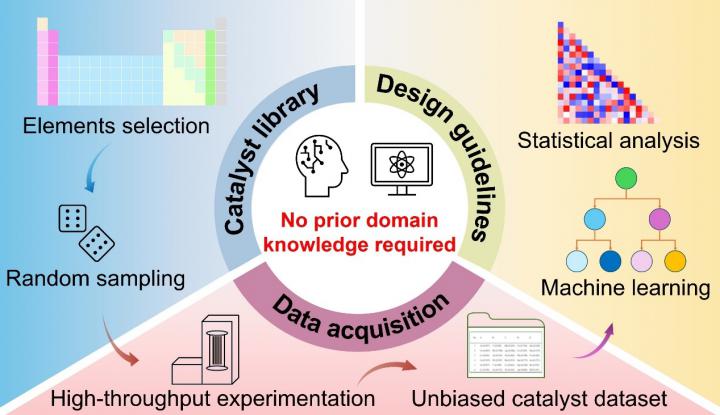
Taniike Lab.
MENU











2025.01.05 by Wentao DUThe traditional approach to designing solid catalysts has been time-consuming and labor-intensive, relying on trials and errors guided by prior knowledge and hypotheses. Recently, combining machine learning with high-throughput experimentation, researchers are exploring uncharted chemistry without preconceptions or biases. Our study exemplifies this shift, focusing on methane dry reforming—a key reaction for sustainable energy and greenhouse gas mitigation. We constructed an unbiased dataset of 256 γ-Al2O3-supported catalysts, each with random combinations of 17 elements from the periodic table. This eliminates assumptions about optimal elements, allowing us to discover surprising trends and catalysts through machine learning.

2024.04.24 by 谷池 俊明 Toshiaki TaniikeInternal donors (IDs), organic Lewis bases, have been the major drivers in the evolution of the Ziegler-Natta catalyst for propylene polymerization. However, the discovery of new ID molecules remains a highly empirical and demanding task. Artificial intelligence methods offer promise but lack a quality dataset. Here, the teams of JAIST and U-Naples collaborate to establish an integrated high-throughput workflow encompassing catalyst synthesis, propylene polymerization, and polypropylene characterization. Its application to an ID library generated a robust and consistent dataset, allowing to establish accurate machine learning models via molecular fingerprinting and feature selection. This synergy will lead to accelerated research and development of the Ziegler-Natta catalyst.

2024.01.19 by Joao Marcos DA SILVEIRAInternal donors are essential organic components of the heterogeneous Ziegler-Natta catalyst in producing high-quality polypropylene. However, their capability of shaping the catalyst structure during its preparation has been long overglanced, though it constitutes the basis of generating desired active sites. To address this issue, we applied our previously established method combining density functional theory and a genetic algorithm to the non-empirical structure determination of the catalyst. The result is an unprecedented view on the internal donor-induced support reconstruction at a molecular level, that shows how donor’s adsorption preferences and capabilities cause a drastic increase in the stereospecific Ti species and dictate the diversity in the Ti local environment, possible cause of the widely known effect of donors on the molecular weight distribution.

2024.01.12 by 谷池 俊明 Toshiaki TaniikeThere is a growing interest in leveraging machine learning to accelerate research and development of practical materials such as catalysts. This involves the use of data to train machines and variables (descriptors) to predict the functions of materials. Particularly, for accurate prediction, descriptors that efficiently and comprehensively incorporate factors influencing the functions are essential. We developed an automatic feature engineering technique that works with only a small amount of training data without requiring any prior knowledge. It generates and screens a large number of features (hypotheses) to select descriptors, essentially serving as hypothesis screening. The technique outperformed traditional techniques in the prediction accuracy, regardless of target catalysis, and was able to pinpoint various high-performing catalysts from a vast pool of catalysts.

2023.12.06 by 柳山 鏡 Kyo YanagiyamaPhotocatalytic reactions are gaining attention as a method for water purification. One of the challenges in this field is the lack of practical research and application knowledge under realistic environmental conditions. In this study, we have developed a new high-throughput screening method capable of conducting photocatalytic reactions in parallel across 132 experiments, leading to significant insights into environmental water purification using visible light-responsive photocatalysts. The research revealed that specific ions in environmental water significantly reduce the activity of the catalysts. Furthermore, to develop effective catalysts in environmental waters, we incorporated 15 types of noble metal nanoparticles into the photocatalysts. As a result, it was discovered that metal nanoparticles, like Au and Pt, which possess high work functions and oxidation resistance, convert environmental ions into active species and demonstrate high activity.














